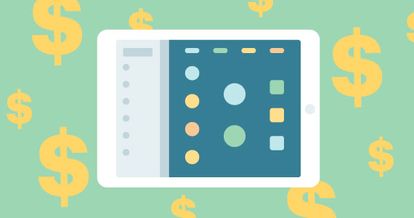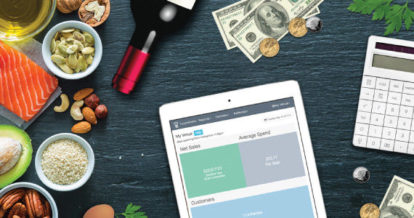“The chefs write the music and the menu becomes the lyrics, and sometimes the music is gorgeous and it’s got the wrong lyrics and the lyrics can torpedo the music.”
– Danny Meyer, Restaurateur, Tabla
While a menu might seem to be an arbitrary list of appetizers, mains and desserts, an effective menu is anything but a mishmash of steak, pastas, and pizza smooshed together haphazardly. Strategy prevails in even the smallest details – from the dish’s title, to the item it’s placed beside, to the price, to the visual accompaniment.
Defined as, “the study of the profitability and popularity of menu items and how these two factors influence the placement of these items on a menu,” the practice of optimizing menu profitability is called Menu Engineering. The main objective is to increase profits through the strategic placement of products. In fact, a menu redesign can serve to increase your profits over 15%!
Entire careers are devoted to this profession, but to help you put on your menu engineering hat for your next redesign, here are some of the ways menu engineers work their magic to help restaurants get the most bang out of every item’s buck.
Costing Analysis
The first step to the menu engineering process is to break down each dish by ingredient to find out the true cost of a meal. This understanding of true costs is an essential step because everything is based on the core price of a dish in relation to it’s popularity. So, don’t skip this step – it’s here you want to count every nickel, dime and penny. By determining the truest base cost, you can base markups on your desired profit margin and determine which category each item should be placed in.
Placement and Categories
Your menu items aren’t simply categorized as breakfast, lunch and dinner. Nor are they solely categorized as appetizer, mains or dessert. You want to categorize menu items in a lesser-known way: as stars, plowhorses, puzzles, and dogs.
According to Menu Cover Depot – a supplier of leather menu covers – you can determine which menu items fall into the appropriate category by doing an analysis on profitability and popularity. The categories are:
- Stars: items that yield both high on the profitability scale and are also highly popular dishes.
- Plow-horses: dishes that might have low profitability but they rank high in popularity.
- Puzzles: the plates that appeal to only a certain few, but are highly profitable.
- Dogs: dishes that have both low profitability and low popularity.
- Knowing which item fits into which category is essential for the placement of each item on your menu, and also requires a robust set of analytics. In order to accurately determine which item is which, you’ll need to conduct a costing breakdown and also compare it to sales analytics drawn from your POS.
Naming and Descriptions
Which would you choose? “Imperial Golden Dragon Sushi” or “Cold Dead Fish on Rice”?
“Chicken Liver” or “Boodie’s Chicken Liver Masala”? “Vitello Al Funghi” or “Veal with Mushrooms”?
What’s in a name? When it comes to menu items – everything! Naming an item with an exotic title can make a rudimentary dish enticing, while using a tongue-in-cheek title can make a dish less intimidating for those with less adventurous tastebuds. The strategy you choose should be reflective of your audience and consistent with your branding.
Whatever direction you go, the name should align with the following goals: to wet paletes, to highlight a taste and/or to highlight an ingredient. Some menu engineers will even create less appetizing descriptions for items considered Dogs and Plow-horses, and more appetizing descriptions for the profit generating Stars and Puzzles.
The Number of Items
Ahhhh, yes. The paradox of choice is such that the more choices we have, the more anxiety we feel. According to menu engineer Gregg Rapp, seven is the ticket number to providing guests with just enough choice without the anxiety that paralysis them into reverting back to something they already know – like one of the “Dog” items. “When we include over seven items, a guest will be overwhelmed and confused, and when they get confused they’ll typically default to an item they’ve had before.”
Design
The key to good design it to understanding how the eye moves across the page.
- The golden triangle: Also known as the high rent area of your menu, this is the centre block of a three column menu. The eye naturally gravitates here first.
- Top right of the Golden Triangle: From the golden triangle, the eye moves easily to the top right, which is another hot spot for profit-generating dishes.
- Negative Space: White space allows the eye to rest and thus, reduces stress on the customer allowing them to make a more thoughtful decision, without entering the dreaded anxiety of the paradox of choice. Items that are on their own, separated from the herd, stand out in whitespace – a good place for your more profitable items.
Visualize
Think of Pavlov’s dog. Similarly to the ringing bell, when we humans see something delicious, our hunger response is activated. That’s why they call it food porn, and also why you should never grocery shop while hungry.
On the other end of the spectrum, triggering this response with visuals is exactly what restauranteurs want: customer sees image, customer drools, customer orders half the menu.
Brian Mennecke, an associate professor of information systems, says that, “The more vivid the image, in terms of movement, color and accuracy of representation, the more realistic, the more it’s going to stimulate your response to it,” According to Greg Rapp, including a picture of food increases sales by 30%. Another study found that when testing a digital display of salad at camp, campers who saw the salad were 70% more likely to order it for lunch. Long story short: pictures sell.An effective way to use images is to embed images of your star and puzzle items into your digital iPad POS menu or, if using a print menu, to showcase your specials, depending on your menu layout.
Play with Price
Restaurant menu pricing is a fickle thing. Everyone wants the lobster tail but not everyone wants to fork out the dough to pay for it. And yet, they might just order the slightly cheaper, equally as delicious, lobster linguini to satisfy their lobster craving. Here are a couple of strategies menu engineers employ regarding price:
- Placing Expensive Items First: By placing more expensive items first, everything preceding that item seems much more reasonable. This is also a common cognitive bias known as “anchoring”, whereby the human tendency is to “heavily rely on the first piece of information offered when making decisions.”
- Removing the $: You’ll see this on a lot of modern menus, prices listed without the dollar sign. Why? Restaurant consultant Aaron Allen says, “We get rid of dollar signs because that’s a pain point. They remind people they’re spending money.” Additional strategies include rounding prices a dollar down, rather than up – 22.95 vs. 23 – or not using numbers at all, favouring a completely written out approach.
- Bookending Star items with a Dog and a Puzzle: Placing a “high profitability, high popularity” item within the brackets of a “low profitability, low popularity” item and a “high profitability, low popularity” item makes that Star item even more appealing.
By incorporating the tips above you can increase your average customer spend and get more insight into your business. And if you’re looking for a short-term spike in your sales, offering promotions, including what is an LTO, can be an easy way to do so. Make your menu make you money.
Download our free inventory template
Sign up for our free weekly TouchBistro Newsletter







